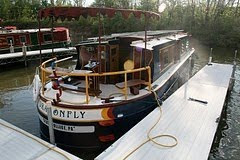 |
| Like the Olde West, but with a lakefront view |
It's probably just the architecture of the period; much of the West was settled in the second half of the 19th century, which is when St. Ignace was enjoying a bit of an economic boom, as the railroad came in.
There were even ferries that took train cars across the straits of Mackinac. The enormous ferry dock is still there on the waterfront, overgrown with weeds. Today the main economic drivers seem to be tourism and a Native American-run casino six miles up the road. Popular snacks at local restaurants: smoked whitefish and "pasties." (We tried both)
We stayed three days in St. Ignace, waiting out the weather. Each morning the forecast said, "Wind 20 knots, waves 4 to 6 feet," which is more than a canal boat can handle! Thursday morning we were up at 6:00 AM to take advantage of a good forecast. As the sun rose we were creeping out of the harbor; the moon, just past full, was high in the western sky.
A few miles down the coast we came to a landmark for the region--and a structure that marked another turning point in our voyage. As we sailed under the famous Mackinac Bridge, we officially left Lake Huron to enter Lake Michigan.
When the idea of a bridge across the Straits of Mackinac was first conceived, many people thought its construction would be impossible--the water too deep and too turbulent, bedrock not sufficient, winds and current too strong. But the bridge was completed, in 1957, and at the time it was the longest
suspension bridge in the world--more than a mile between those two huge suspension towers and six miles long overall. It's cars-and-trucks only for most of the year, but in the fall the governor leads citizens in a "bridge walk" across the span.
Once under the bridge we saw three more enormous freighters, and also the white sails of six sailboats strung out in a line, headed home from a yacht race (more on that later). Half an hour later, we were skimming the coast, all alone . . . and we saw no more boats the rest of the day.
The coastline here is very different from Georgian Bay and the North Channel on Lake Huron. No more pink granite, no more little islands, no cliffs of white quartzite, hardly any settlements or cottages. Instead, a long green line of spruce and cypress, fronted sometimes by shelves of dark shale, sometimes by narrow sandy beaches . . . and sometimes by sand dunes that would look quite at home on Cape Cod.
After a long day's cruising out past the town of Naubinway we anchored out in a shallow cove where we had what sailors call a "bouncy" night. I told myself it was just like sleeping in a hammock.








No comments:
Post a Comment